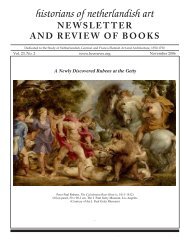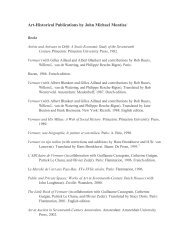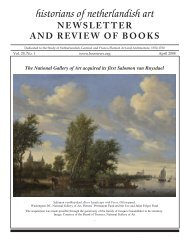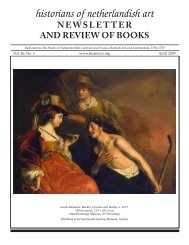newsletter - Historians of Netherlandish Art
newsletter - Historians of Netherlandish Art
newsletter - Historians of Netherlandish Art
Create successful ePaper yourself
Turn your PDF publications into a flip-book with our unique Google optimized e-Paper software.
the more than 20 paintings by Van Dyck (14 are still accepted<br />
today). Rembrandt’s Passion cycle and Raphael’s Holy Family<br />
from the Canigiani collection (a gift from Johann Wilhelm’s<br />
father-in-law, Cosimo III de Medici), are other highlights.<br />
Among contemporary artists, Johann Wilhelm greatly admired<br />
the work <strong>of</strong> Adriaen van der Werff (1659-1722) from Rotterdam,<br />
his court painter for nearly twenty years, who is represented by<br />
close to 40 paintings. For decorations in his private apartments<br />
and the newly built castle Bensberg the Elector commissioned<br />
Antonio Bellucci (1654–1726) and Giovanni Antonio Pellegrini<br />
(1675-1741) from Venice (today in the Bayerische Staatsgemäldesammlungen,<br />
Munich). Instrumental in the paintings’<br />
acquisition was the Dutch artist Jan Frans van Douven (1656-<br />
1727), since 1682 Johann Wilhelm’s court painter, who installed<br />
the collection in the Kunsthaus, unfortunately pulled down in<br />
the nineteenth century.<br />
The Elector also involved his close relatives in securing<br />
works as well as his second wife, Maria Luisa, who was<br />
instrumental in the negotiations leading to the acquisition <strong>of</strong><br />
Rubens’s Last Judgement, the enormous altar in the Neuburg<br />
Jesuit church that his grandfather, Wolfgang Wilhelm had commissioned<br />
from Rubens in 1616. Johann Wilhelm was among<br />
the fi rst to collect altarpieces; in the process he was required to<br />
have a copy painted <strong>of</strong> the altar he was purchasing to replace<br />
the original in the church. For a detailed account on the formation<br />
<strong>of</strong> Johann Wilhelm’s collection see Susan Tipton, “’La<br />
Passion mia per la pittura’,” Münchner Jahrbuch der bildenden<br />
Kunst, 3rd series, vol. LVII, 2006, pp. 71- 331, who publishes<br />
the documents regarding the acquisition and exchanges <strong>of</strong> the<br />
many works <strong>of</strong> art.<br />
In 1719, three years after Johann Wilhelm’s death, appeared<br />
the fi rst printed catalogue <strong>of</strong> the Elector’s art collection<br />
by Johann Georg Karsch (died 1753), the gallery’s director, dedicated<br />
to Elector Karl III Philipp. Besides the paintings, Karsch’s<br />
inventory also mentioned precious tables and small bronze<br />
and ivory sculptures (see Kornelia Möhlig, Die Gemäldegalerie<br />
des Kurfürsten Johann Wilhelm von der Pfalz-Neuburg (1658-1716)<br />
in Düsseldorf, [Ph.D. diss. Bonn], Cologne, 1993). The second,<br />
a visual inventory <strong>of</strong> the art Johann Wilhelm collected, was a<br />
folio <strong>of</strong> engravings that reproduced all the paintings hanging<br />
in the Düsseldorf Kunsthaus and in the large staircase leading<br />
up to it from the castle: Estampes du catalogue raisonné et fi guré<br />
des tableaux de la galerie électorale de Dusseldorff (Basel, 1778) with<br />
engravings by the Basel publisher and engraver Christian von<br />
Mechel (1737-1817) and a catalogue in French by Nicolas de<br />
Pigage (1723-1796). The publication, originally in a text and<br />
plate volume, was dedicated to Elector Karl Theodor von der<br />
Pfalz (1724-99).<br />
The folio opens with an allegorical frontispiece honoring<br />
Karl Theodor, followed by the plan, façade and cross section<br />
<strong>of</strong> the Kunsthaus (plates A-D) and twenty-six plates <strong>of</strong> engravings,<br />
each reproducing mostly between 8 and 20 paintings in<br />
their original, rather spacious hanging, <strong>of</strong>ten arranged around<br />
a large center piece with smaller works placed more or less<br />
symmetrically along either side. The fi rst two rooms included<br />
primarily Flemish paintings anchored by De Crayer’s high<br />
altar from the Augustinian church in Brussels, among Johann<br />
Wilhelm’s last acquisitions, surrounded by the more than<br />
twenty works by Van Dyck, among them Susanna and the Elders,<br />
a Lamentation, two Saint Sebastians, and several fi ne portraits.<br />
Additional works exhibited at the beginning were by Snyders,<br />
Fyt, Van Egmont, Van Thulden, and Jordaens. The Dutch school<br />
was represented by Jan Weenix, Bloemaert, and Honthorst with<br />
an occasional Italian painting (Titian, Giordano, Palma); the latter<br />
school was predominant in Room 3. Here we fi nd paintings<br />
by Raphael, the Carracci, Tintoretto, Veronese, several by Luca<br />
Giordano and a lone work by Poussin. Among the eight Rembrandts<br />
in Room 4 were the Passion paintings, the Adoration <strong>of</strong><br />
the Shepherds, and two portraits (now called Bol), together with<br />
no less than 23 works by Adriaen van der Werff, among them<br />
the fi fteen for the Mysteries <strong>of</strong> the Rosary. In midst <strong>of</strong> these we<br />
fi nd Titian’s Portrait <strong>of</strong> a Young Man, Jordaens’s Satyr Visiting the<br />
Peasant, Guido Reni’s Assumption <strong>of</strong> the Virgin, and Velazquez’s<br />
Young Nobleman, one <strong>of</strong> the few Spanish works in the Kunsthaus.<br />
In Room 5 at the end, all 46 Rubens paintings were shown,<br />
reproduced on fi ve plates. The remaining four plates reproduce<br />
70 small-scale paintings installed on panels that covered the<br />
windows.<br />
Von Mechel recorded the 358 paintings exhibited in the<br />
Kunsthaus in small engravings on 26 large plates in accordance<br />
with their hanging, the Galerie Électorale de Dusseldorf.<br />
Each work is reproduced in fi ne detail in the order they were<br />
installed in the fi ve rooms, identifi ed with the artist’s name<br />
and a number that corresponded to the 1719 Karsch inventory.<br />
The present folio facsimile edition reproduces the hanging <strong>of</strong><br />
1763 after the collection was newly installed by the then gallery<br />
director and painter Lambert Krahe (1712-90). The fi rst Düsseldorf<br />
installation, according to Karsch, showed Rubens’s<br />
enormous Last Judgement – his largest painting and one <strong>of</strong> fi ve<br />
monumental works by the artist – in the centre hall with the<br />
Kunsthaus built around it. In the 1778 publication the hanging<br />
was rearranged so that the visitor was greeted in the fi rst room<br />
by Van Douven’s large equestrian portrait <strong>of</strong> Johann Wilhelm<br />
above the door and then proceeded slowly to Room 5, the highpoint<br />
at the end where all the Rubens paintings were installed.<br />
The De Pigage-Von Mechel volume also includes engravings<br />
after seven allegorical paintings in grisaille by Johann Georg<br />
Karsh that decorated the gallery’s staircase.<br />
The 2009 facsimile publication ends with a list <strong>of</strong> the 358<br />
works arranged by inventory number with references to plates,<br />
artists, title, medium and size, and the present location (pp.<br />
98-113). An alphabetical list <strong>of</strong> the artists with a brief mention if<br />
attributions differed from those found in De Pigage’s 1778 catalogue<br />
–primarily among the Italian works and some by Rubens<br />
– concludes the volume.<br />
Christian Quaeitzsch catalogues these works fully in<br />
Kurfürst Johann WiIhelms Bilder. Vol. II: Galerie und Kabinette,<br />
recording 337 paintings seen there until 1719 (pp. 21-133). All<br />
are illustrated in black and white and listed alphabetically<br />
by artist, title, medium and size, current inventory numbers,<br />
and references beginning with the fi rst catalogue by Gerhard<br />
Joseph Karsch <strong>of</strong> 1719 up to the recent Munich catalogues <strong>of</strong><br />
2005 (Neuburg), 2006-09. Paintings that were auctioned or lost<br />
were illustrated whenever possible from Von Mechel’s engravings.<br />
After the Elector’s death in 1716, some 160 paintings were<br />
added between 1719 and 1778 (pp. 135-55, nos. 338-398) and incorporated<br />
into the Düsseldorf gallery for a total <strong>of</strong> 398 works;<br />
all are again illustrated in black and white where possible or<br />
shown in Von Mechel’s 1778 engravings. During the preparation<br />
<strong>of</strong> the exhibition it could be established that only 76 paintings<br />
were missing; 17 are still known but no longer in the Alte<br />
Pinakothek, while nine were auctioned in 1851 and some were<br />
lost during the war or deaccessioned.<br />
Another group <strong>of</strong> 253 small-scale paintings was installed<br />
HNA Newsletter, Vol. 27, No. 2, November 2010<br />
29







